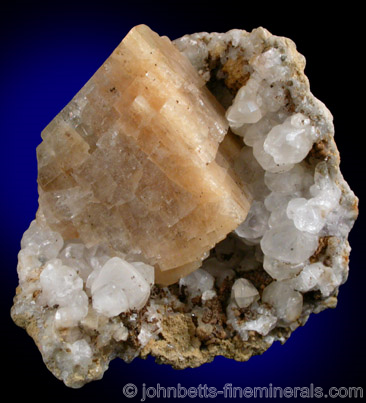The Mineral chabazite

Since its original classification, Chabazite was always regarded as a
single mineral species with a variable elemental makeup. In 1997,
the Zeolite Subcommittee of the IMA divided this mineral into
individual sub-species, thereby regarding Chabazite as a series of
four members. The series is defined by the presence of several variable
elements in the following order: calcium, sodium, potassium, and strontium. Calcium-dominating Chabazite is called Chabazite-Ca, and
is by far the most prevalent form of this series. Sodium-dominating Chabazite is next most common, and is known as Chabazite-Na,
followed by potassium-dominating Chabazite known as Chabazite-K.
Strontium-dominating Heulandite is known as Chabazite-Sr, and is extremely rare. A magnesium-dominating Chabazite was recently described from Hungary, though it is not officially recognized as an individual mineral species by the IMA. Almost all Chabazite specimens in
collections are Chabazite-Ca. A distinction among the different Chabazite types is rarely made, and the members are generally just
termed Chabazite without further breakdown.
Chabzite is very similar in structure and habit to the closely related Gmelinite. Gmelinite often forms as a pseudomorph after Chabazite, retaining the original rhombic shape but forming modified faces.
Chemical Formula
Chabazite-Ca: CaAl2Si4O12 · 6(H2O)
Chabazite-Na: (Na2,Ca)Al2Si4O12 · 6(H2O)
Chabazite-K: (K2,Ca,Na2)Al2Si4O12 · 6(H2O)
Chabazite-Sr: (Sr,Ca)Al2Si4O12 · 6(H2O)
Color
White, peach, yellow, gray, orange, pink, and brown. Less commonly colorless, red, green, or multicolored with color zoning.
Properties
Streak
White |
Hardness
4 - 5 |
Transparency
Transparent to translucent |
Specific Gravity
2.0 - 2.2 |
Luster
Vitreous |
Cleavage
3,1 |
Fracture
Uneven |
Tenacity
Brittle |
Crystal Habits
Crystals are rhombohedral, in well-formed and distinct crystals, either individual or in groups. Crystal angles are very close to 90 degrees, thus making the crystals appear similar to cubes. Crystals sometimes have thin growth layers or very minor curving. Cubic-shaped penetration twins are relatively common, and multiple penetrations are also known, and these result in rounded, ball-like formations. Also grainy, in drusy plates, in groups of penetrated crystals, and massive.
Additional Information
Composition
The most prevalent form of Chabazite, Chabazite-Ca, is hydrous calcium aluminum silicate, and often with some sodium and potassium. Chabazite-Na and Chabazite-K have sodium and potassium dominating the calcium, and may also contain minor magnesium. Chabazite-Sr contains a strontium in place of some of the calcium. |
In Group
Silicates; Tectosilicates; Zeolite Group |
Striking Features
Crystal habits, glassy luster, and mode of occurrence. |
Environment
Most often in volcanic basalt cavities, and in diabase veins. Occasionally in
altered cavities in metamorphic rock such as hornfels and gneiss. |
Rock Type
Igneous |
Varieties
-
A bronze-colored Chabazite once found in the gneiss of the Jones Falls area in Baltimore, Maryland.
-
Synonym of Chabazite-Na. This was the official name of the mineral prior to the renaming of Chabazite into a series by the Zeolite Subcommittee of the IMA.
Noteworthy Localities
Chabazite comes from many of the well-known zeolite occurrences, though it is surprisingly sparse at the Deccan Traps of India. However, a new find of large, quality crystals was recently described at Nasik, in Maharashtra State. Large and well-formed crystals come from Teigarhorn, Berufjord, Iceland; and sharp white crystals from several localities in the Faroe Islands of Denmark. Well-formed, peach colored pseudocubic Chabazite clusters are found in Imilchil, Morocco. White Chabazite, especially the Phacolite variety, was found at the Maglovec Quarry, Vyšná Šebastová, Slovakia; and good Phacolite clusters came from Gads Hill, Upper Mersey Valley, Tasmania, Australia.
In the U.S., the best Chabazite comes from the Upper and Lower New Street Quaries, Paterson, Passaic Co., New Jersey; and nearby at Prospect Park, Passaic Co., New Jersey. White and colorless crystals come from the Burnt Cabin Creek, Spray, Wheeler Co., Oregon; and white crystals plates in basalt vugs are found in North Table Mountain, Golden, Jefferson Co., Colorado.
Some of the most outstanding Chabazite crystals come from Nova Scotia, Canada, where they are found in sharply-colored orange rhombohedral crystal groups and plates. Specific noteworthy localities include Wasson Bluff, Parrsboro; and Cape Blomidon, on the Bay of Fundy.
Distingushing Similar Minerals
Apophyllite - Has perfectly straight crystal angles, as opposed to Chabazite which are slightly angled; Apophyllite crystals also often striated and with different terminations.
Calcite - Lower hardness and luster different.
Gmelinite - Different crystal formation and generally has a sharper luster.